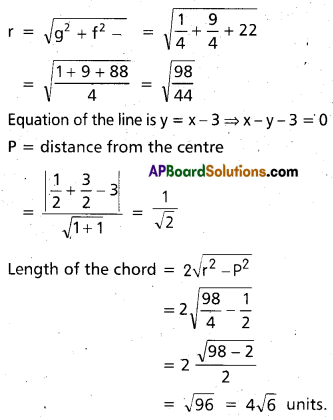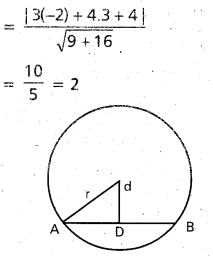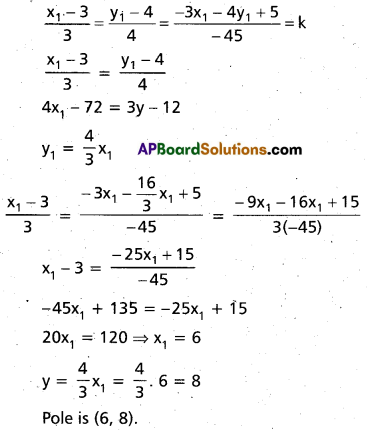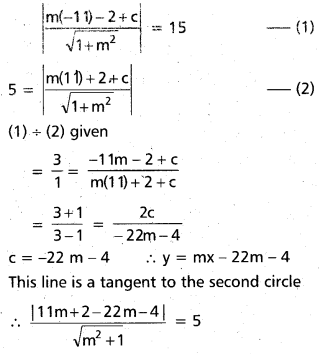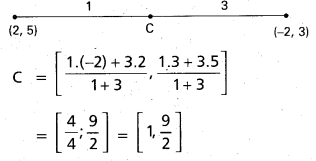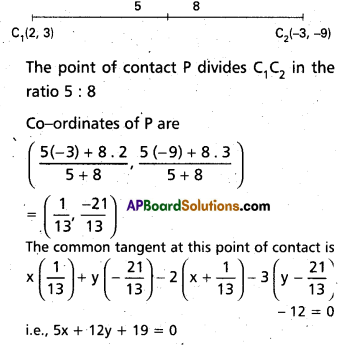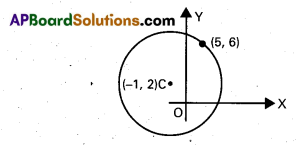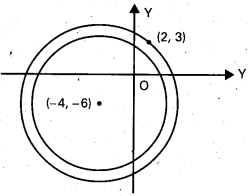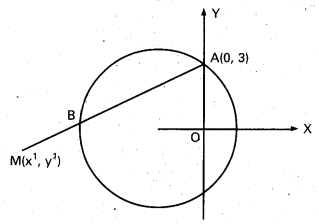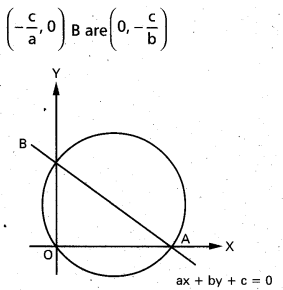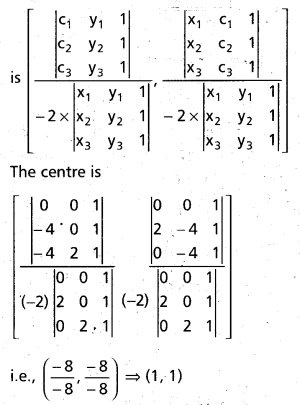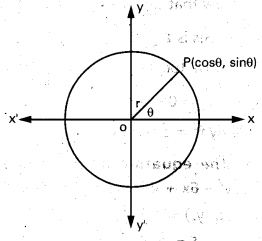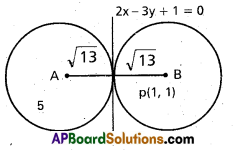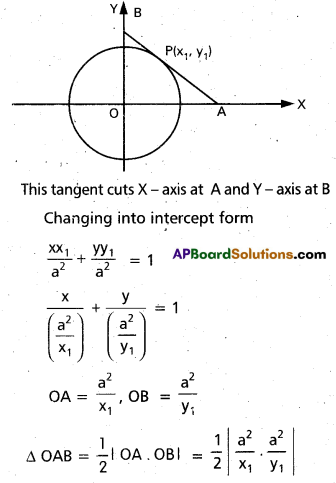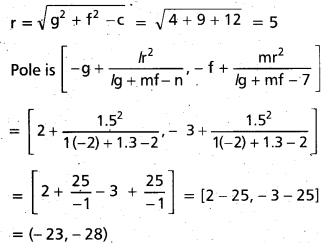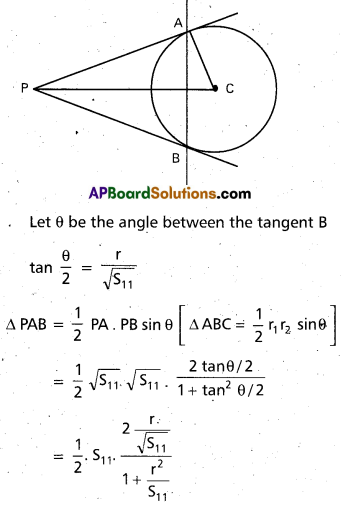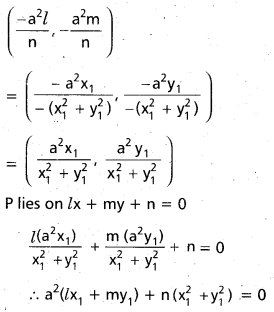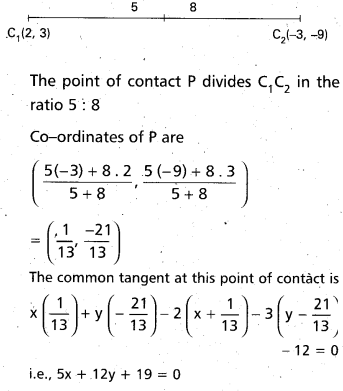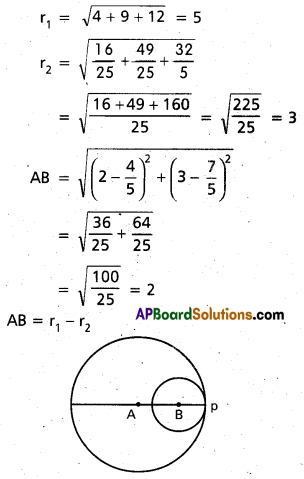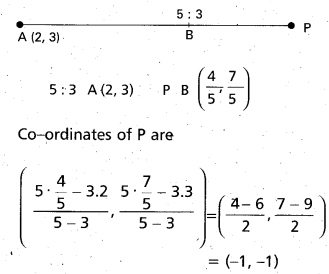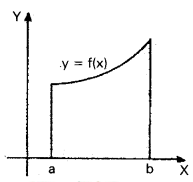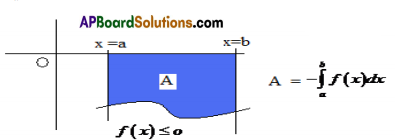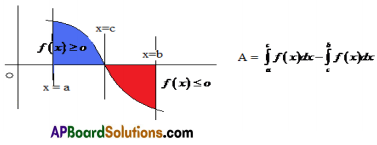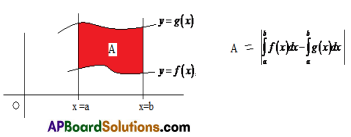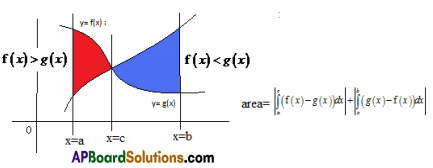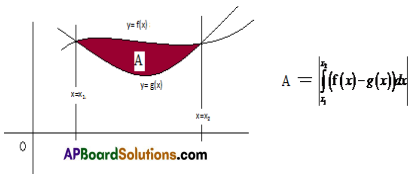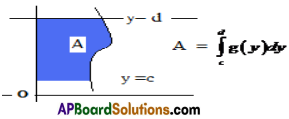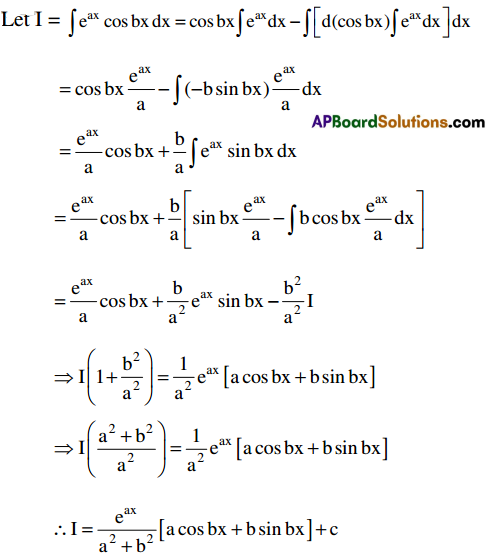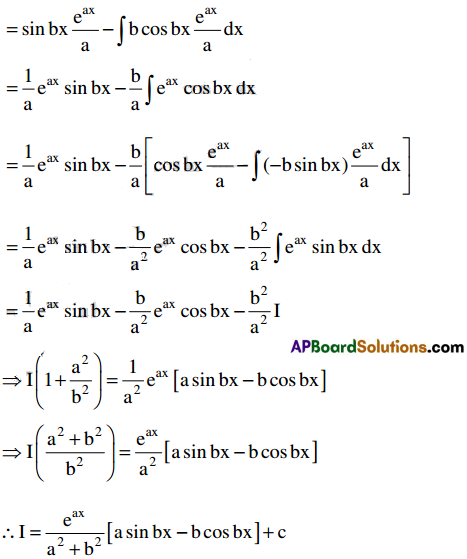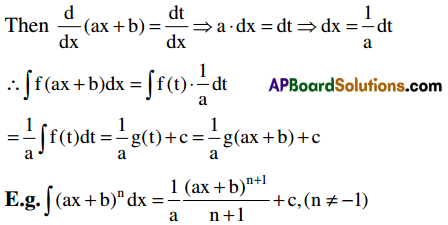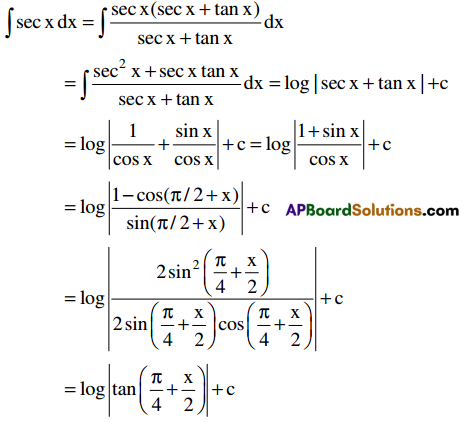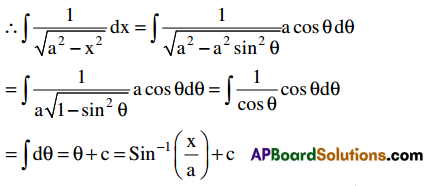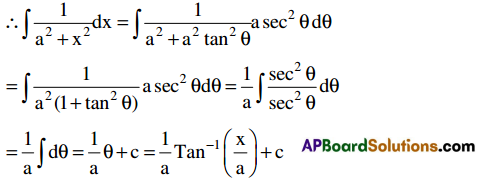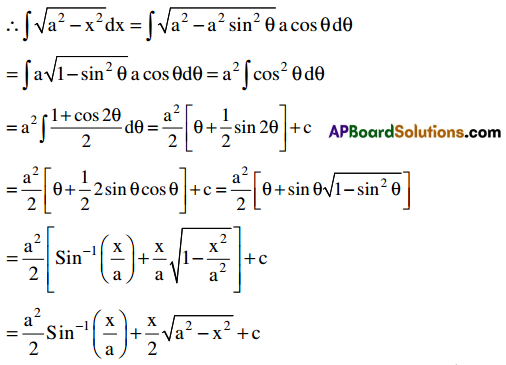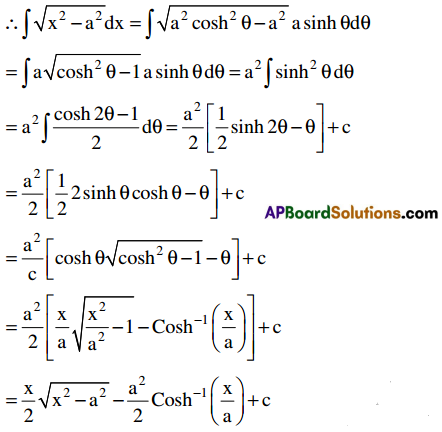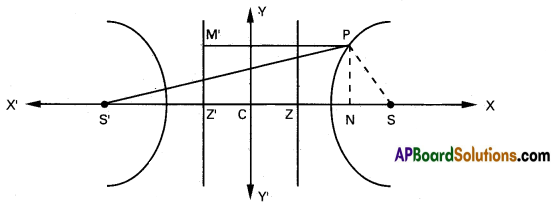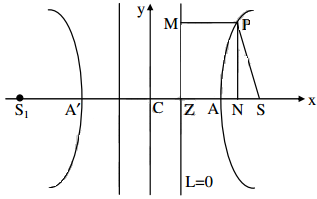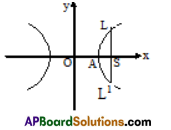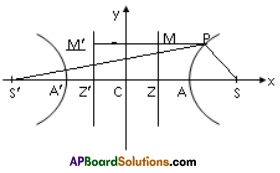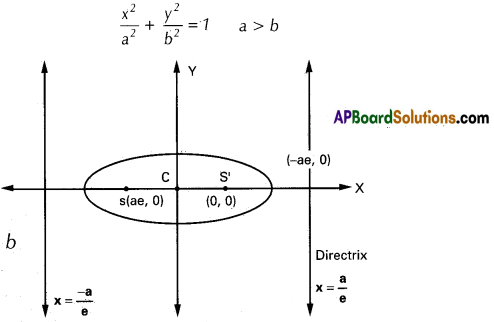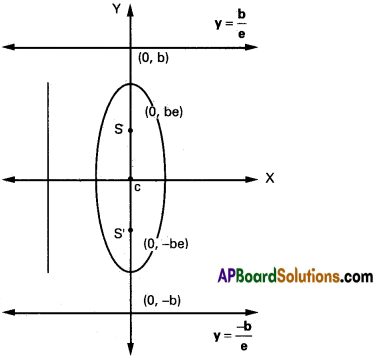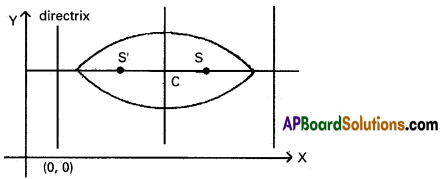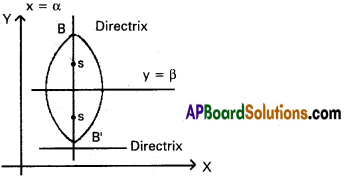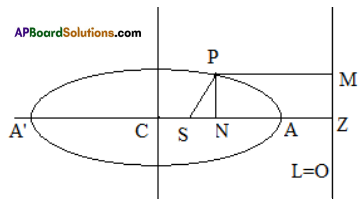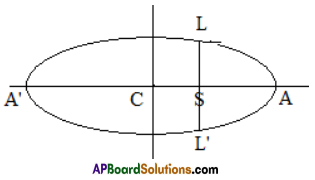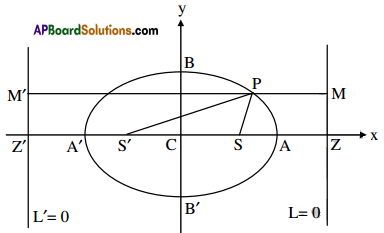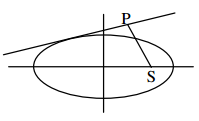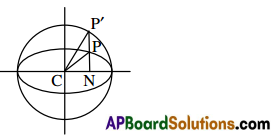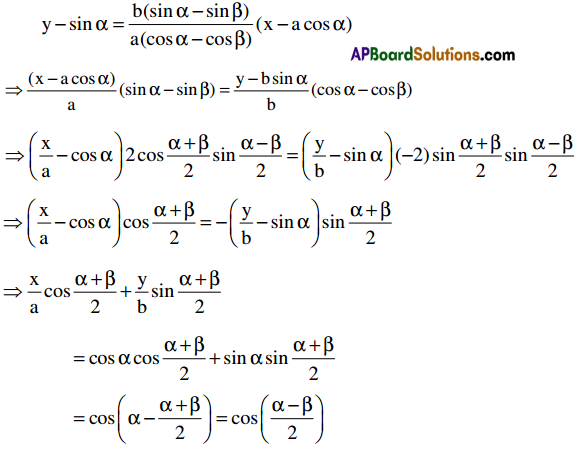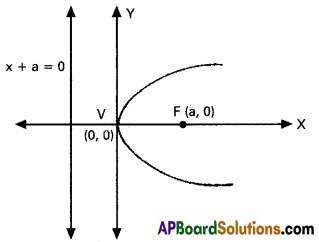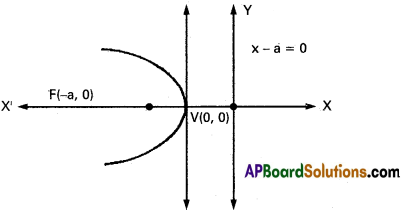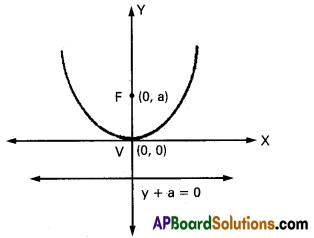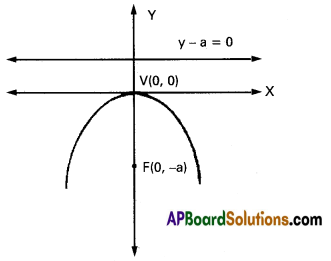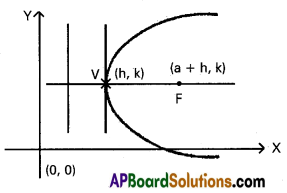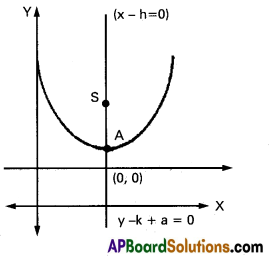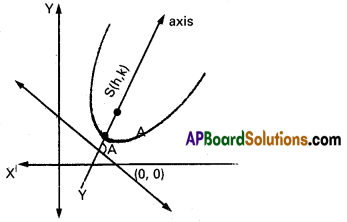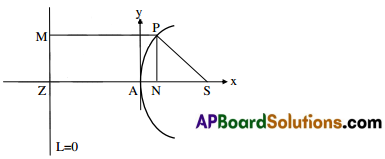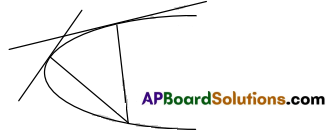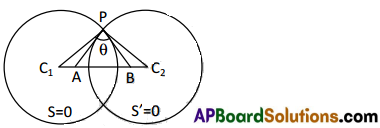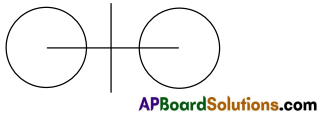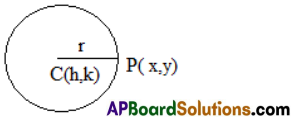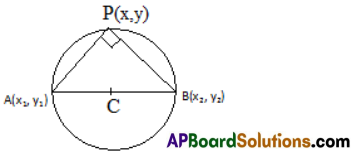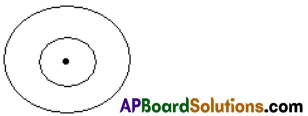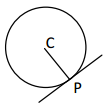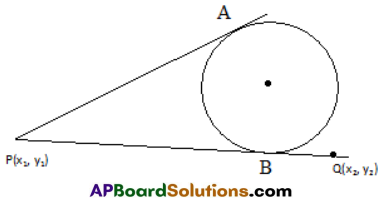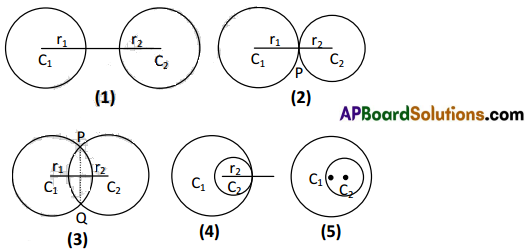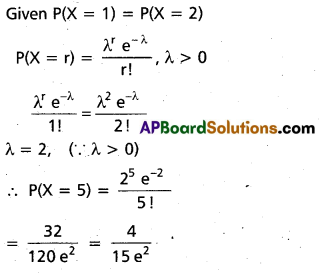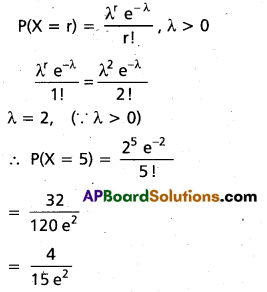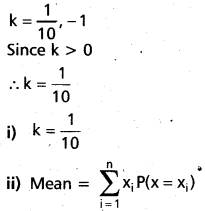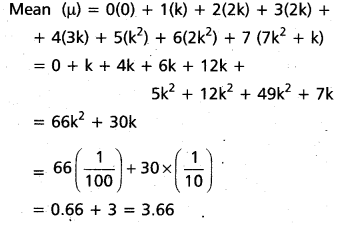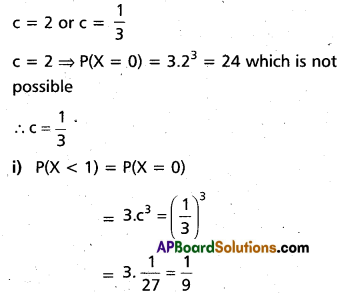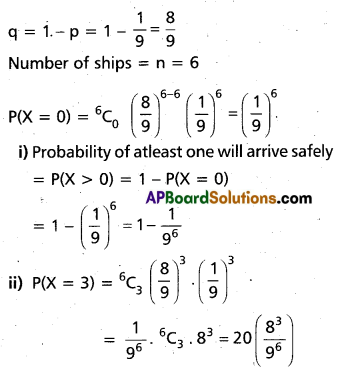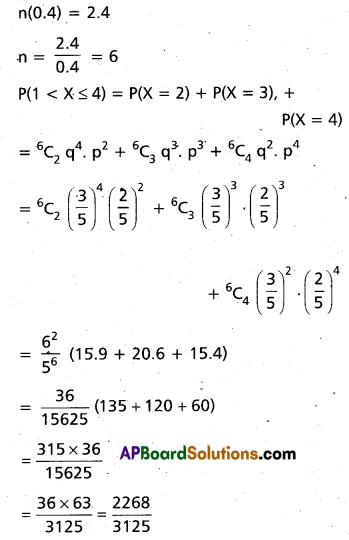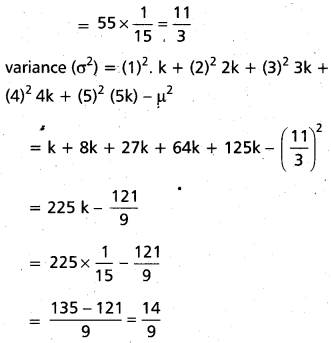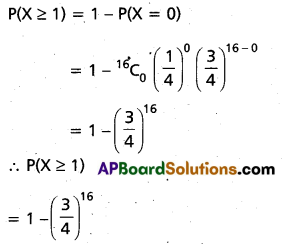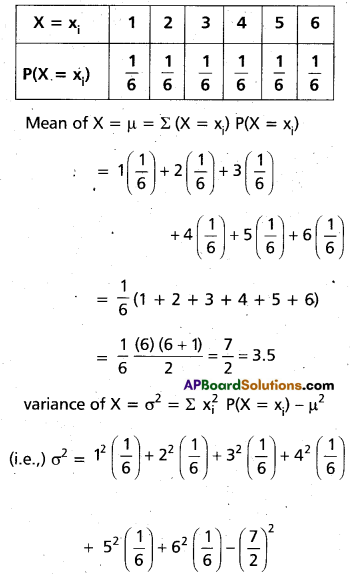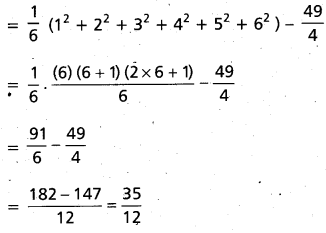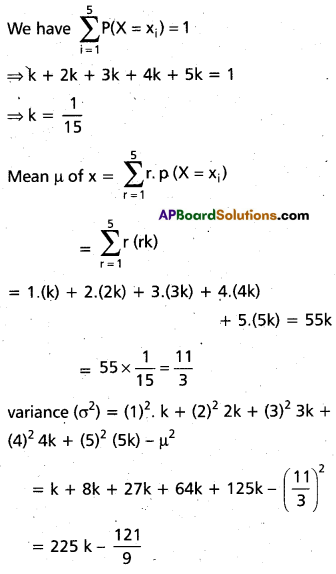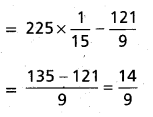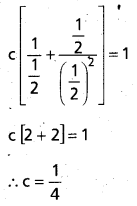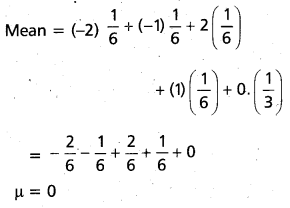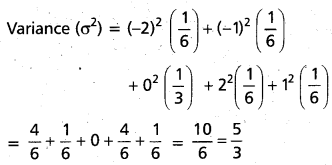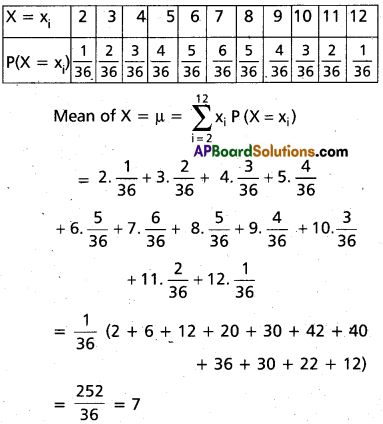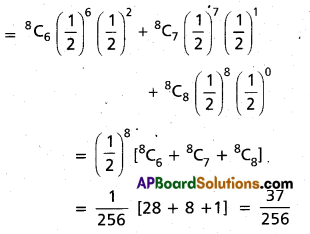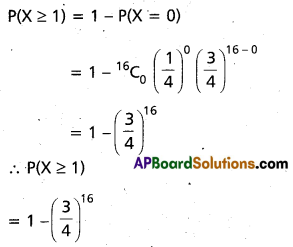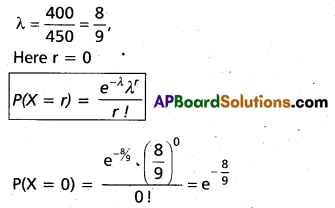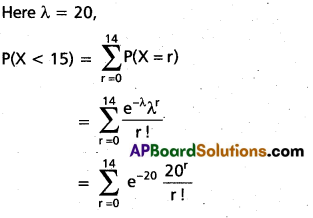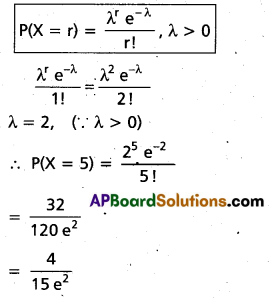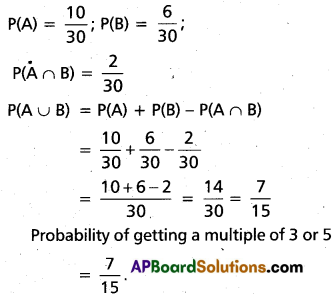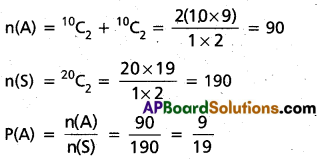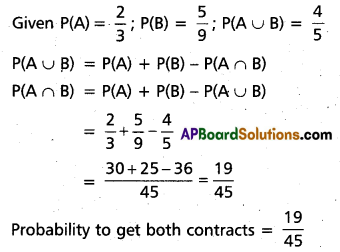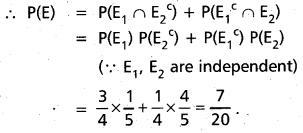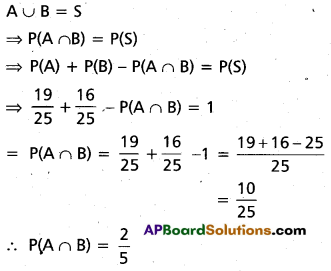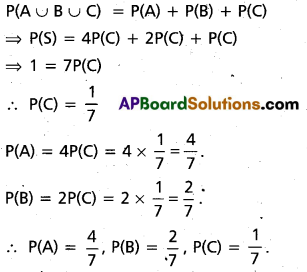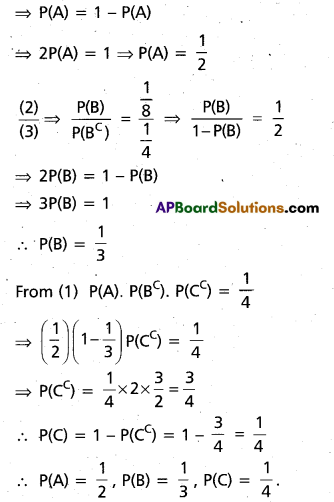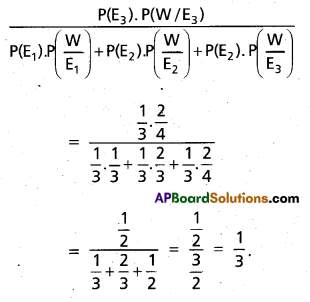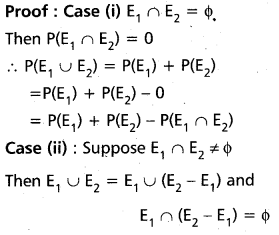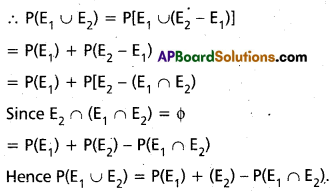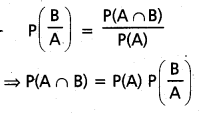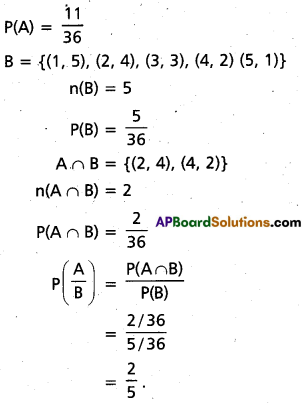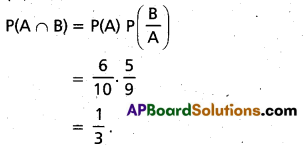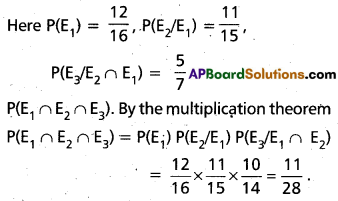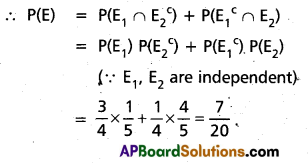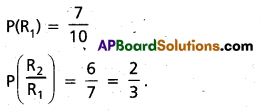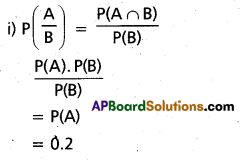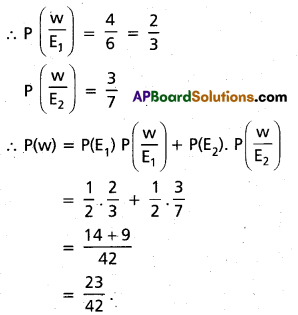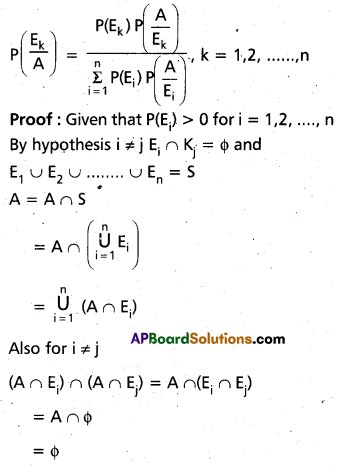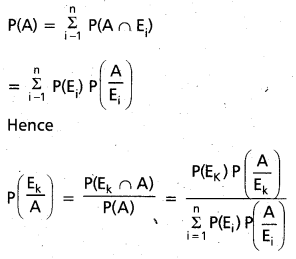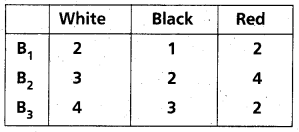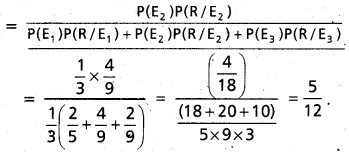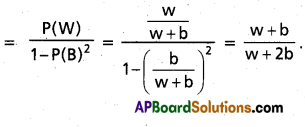Students get through Maths 2B Important Questions Inter 2nd Year Maths 2B System of Circles Important Questions which are most likely to be asked in the exam.
Intermediate 2nd Year Maths 2B System of Circles Important Questions
Question 1.
x2 + y2 + 4x + 8 = 0, x2 + y2 – 16y + k = 0 [A.P. & T.S. Mar. 16]
Solution:
g1 = 2; f1 = 0; c1 = 8
g2 = 0; f2 = – 4; c2 = k
Two circles are said to be orthogonal
2g1g2 + 2f1f2 = c1 + c2
2(2) (0) + 2(0) (-8) = 8 + k
0 + 0 = 8 + k
⇒ k = -8
![]()
Question 2.
(x – a)2 + (y – b)2 = c2, (x – b)2 + (y – a)2 = c2 (a ≠ b) [A.P. Mar. 15]
Solution:
(x2 + y2 – 2xa – 2yb – c2)
– (x2 + y2 – 2xb – 2ya – c2) = 0
– 2x (a – b) – 2y(b – a) = 0
(or) x – y = 0
Question 3.
Find the angle between the circles given by the equations. [T.S. Mar.17]
i) x2 + y2 – 12x – 6y + 41 = 0, x2 + y2 + 4x + 6y – 59 = 0.
Solution:
C1 = (6, 3)
r1 =(36 + 9 – 41)1/2
r1 = 2
C2 = (-2, -3)
r2 =(4 + 9 + 59)1/2
r2 = (72)1/2 = 6[latex]\sqrt{2}[/latex]
C1C2 = d = [latex]\sqrt{(6+2)^{2}+(3+3)^{2}}[/latex]
= [latex]\sqrt{64+36}[/latex] = 10
cos θ = [latex]\frac{d^{2}-r_{1}^{2}-r_{2}^{2}}{2 r_{1} r_{2}}[/latex]
= [latex]\frac{100-4-72}{2 \times 2 \cdot \sqrt{72}}=\frac{24}{4 \times 6 \sqrt{2}}=\frac{1}{\sqrt{2}}[/latex]
θ = 45°
![]()
Question 4.
Find the equation of the circle which cuts the circles x2 + y2 – 4x – 6y + 11 = 0 and x2 + y2 – 10x – 4y + 21 = 0 orthogonally and has the diameter along the straight line 2x + 3y = 7. [A.P. Mar. 16; May 07]
Solution:
Let circle be x2 + y2 + 2gx + 2fy + c = 0 ……………….. (i)
Orthogonal to circle
2g (-2) +2f(-3) = 11 + c ……………………. (ii)
2g (-5) + 2f(-2) = 21 + c ……………………. (iii)
Subtracting it we get
-6g + 2f = 10 ……………………… (iv)
Circles centre is on 2x + 3y = 7
∴ -2g – 3f = 7 ……………………. (v)
Solving (iv) and (y)
f = -1, g = -2, c = 3
Equation of circle be x2 + y2 – 4x – 2y + 3 = 0
Question 5.
Show that the angle between the circles x2 + y2 = a2, x2 + y2 = ax + ay is [latex]\frac{3\pi}{4}[/latex] [Mar. 14]
Solution:
Equations of the circles are
S ≡ x2 + y2 – a2 = 0
S’ ≡ x2 + y2 – ax – ay = 0
C1 (0, 0), C2 ([latex]\frac{a}{2}[/latex], [latex]\frac{a}{2}[/latex])
∴ C1C22 = (0 – [latex]\frac{a}{2}[/latex])2 + (0 – [latex]\frac{a}{2}[/latex])2
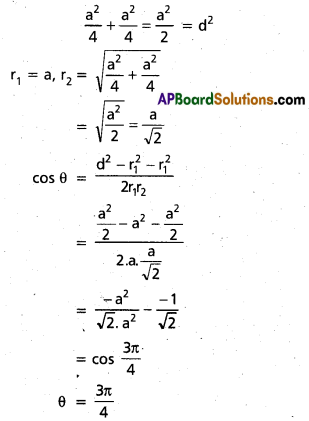
Question 6.
If x + y = 3 ¡s the equation of the chord AB of the circle x2 + y2 – 2x + 4y – 8 = 0, find the equation of the circle having [latex]\overline{\mathrm{AB}}[/latex] as diameter. [A.P. Mar. 15]
Solution:
Required equation of circle passing through
intersection S = 0 and L = 0 is S + λL = 0
(x2 + y2 – 2x + 4y – 8) + λ(x + y – 3) = 0
(x2 + y2 + x(-2 + λ)+ y(4 + λ) – 8 – 3λ = 0 ………………. (i)
x2 + y2 + 2gx + 2fy + c = 0 ……………………. (ii)
Comparing (i) and (ii) we get
g = [latex]\frac{(-2+\lambda)}{2}[/latex], f = [latex]\frac{(4+\lambda)}{2}[/latex]
Centre lies on x + y = 3
∴ [latex]-\left(\frac{-2+\lambda}{2}\right)-\left(\frac{4+\lambda}{2}\right)[/latex] = 3
2 – λ – 4 – λ = 6
-2λ = 8 ⇒ λ = – 4
Required equation of circle be
(x2 + y2 – 2x + 4y – 8) – 4(x + y – 3) = 0
x2 + y2 – 6x + 4 = 0
![]()
Question 7.
If two circles x2 + y2 + 2gx + 2fy = 0 and x2 + y2 + 2g’x + 2f’y = 0 touch each other then show that f’g = fg’. [T.S. Mar. 16]
Solution:
C1 = (-g, -f)
r1 = [latex]\sqrt{g^{2}+f^{2}}[/latex]
C2 = (-g-1, -f-1)
r2 = [latex]\sqrt{g^{\prime 2}+r^{\prime 2}}[/latex]
C1C2 = r1 + r2
(C1C2)2 = (r1r2)2
(g’ – g)2 + (f’ – f)2 = g2 + f2 + g’2 + f’2 + [latex]2 \sqrt{g^{2}+f^{2}} \sqrt{g^{2}+f^{1^{2}}}[/latex]
-2(gg’ + ff’) = 2{g2g’2 + g2f’2 + f2g’2}1/2
Squaring again
(gg’ + ff’)2 = g2g’2 + f2f’2 + g2f’2 + g’2f2
g2g’2 + f2f’2 + 2gg’ff’ = g2g’2 + f2f’2 + g2f’2 + g’2f’2
2gg’ff’ = g2f’2 + f2g’2
⇒ g2f’2 + g’2f’2 – 2gg’ff’ = 0
(or) (gf’ – fg’)2 = 0 (or) gf’ = fg’
Question 8.
Show that the circles
S ≡ x2 + y2 – 2x – 4y – 20 = 0 …………………… (1)
and S ≡ x2 + y2 + 6x + 2y – 90 = 0 …………………(2)
touch each other internally. Find their point of contact and the equation of common tangent. [T.S. Mar. 15]
Solution:
Let C1, C2 be the centres and r1, r2 be the radii of the given circles (1) and (2). Then
C1 = (1, 2); C2 = (-3, -1); r1 = 5; r2 = 10.
C1C2 = distance between the centres = 5
|r1 – r2| = |5 – 10| = 5 = C1C2
∴ The given two circles touch internally. In
this case, the common tangent is nothing but the radical axis. Therefore its equation is S – S’ = 0.
i.e., 4x + 3y – 35 = 0
Now we find the point of contact. The point of contact divides [latex]\overline{\mathrm{C}_{1} \mathrm{C}_{2}}[/latex] in the ratio 5 : 10
i.e., 1: 2 (externally)
∴ Point of contact
= [latex]\left(\frac{(1)(-3)-2(1)}{1-2}, \frac{(1)(-1)-2(2)}{1-2}\right)[/latex]
= (5, 5)
![]()
Question 9.
Find the angle between the circles x2 + y2 + 4x – 14y + 28 = 0 and x2 + y2 + 4x – 5 = 0
Solution:
Equations of the given circles are .
x2 + y2 + 4x – 14y + 28 = 0
x2 + y2 + 4x – 5 = 0
Centres are C1 (-2, 7), C2 (-2, 0)
C1C2 = [latex]\sqrt{(-2+2)^{2}+(7-0)^{2}}[/latex]
= [latex]\sqrt{0+49}[/latex] = 7
r1 = [latex]\sqrt{4+49-28}[/latex] = [latex]\sqrt{25}[/latex] = 5
r2 = [latex]\sqrt{4+5}[/latex] = [latex]\sqrt{9}[/latex] = 3
If θ is the angle between the given circles,
then cos θ = [latex]\frac{d^{2}-r_{1}^{2}-r_{2}^{2}}{2 r_{1} r_{2}}[/latex]
cos θ = [latex]\frac{49-25-9}{2(5)(3)}[/latex] = [latex]\frac{15}{2.5 .3}[/latex] = [latex]\frac{1}{2}[/latex] = cos 60°
Angle between the circles = θ = [latex]\frac{\pi}{3}[/latex]
Question 10.
If the angle between the circles x2 + y2 – 12x – 6y + 41 = 0 and x2 + y2 + kx + 6y – 59 = 0 is 45° find k.
Solution:
Suppose θ is the angle between the circles
x2 + y2 – 12x – 6y + 41 = 0
and x2 + y2 + kx + 6y – 59 = 0
g1 = -6, f1 = -3, c1 = 41,
g2 = [latex]\frac{k}{2}[/latex], f2 = 3, c2 = -59
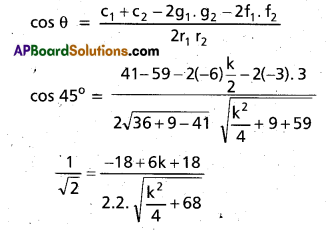
[latex]\frac{1}{\sqrt{2}}=\frac{6 k}{4 \cdot \sqrt{\frac{k^{2}}{4}+68}}[/latex]
Squaring and cross – multiplying
4([latex]\frac{k^{2}}{4}[/latex] + 68) = 18k2
[latex]\frac{2\left[k^{2}+272\right]}{4}[/latex] = 9k2
k2 + 272 = 18 k2
17k2 = 272
k2 = [latex]\frac{272}{17}[/latex]
k2 = 16
k = ±4.
Question 11.
Find the equation of the circle which passes through (1, 1) and cuts orthogonally each of the circles.
x2 + y2 – 8x – 2y + 16 = 0 and …………….. (1)
x2 + y2 – 4x – 4y – 1 = 0. ………………. (2)
Solution:
Let the equation of the required circle be
x2 + y2 + 2gx + 2fy + c = 0 ……………. (3)
Then the circle (3) is orthogonal to (1) and (2).
∴ By applying the condition of orthogonality give in x2 + y2 + 2gx + 2fy + c = 0 we get
2g(-4) + 2f(-1) = c + 16 and …………………. (4)
2g (-2) + 2f(-2) = c – 1 ……………….. (5).
Given that the circle (3) is passing through (1, 1)
∴ 12 + 12 + 2g(1) + 2f(1) + c = 0
2g + 2f + c + 2 = 0 ………………….. (6)
Solving (4), (5) and (6) for g, f and c, we get
g = -[latex]\frac{7}{3}[/latex], f = [latex]\frac{23}{6}[/latex], c = -5
Thus the equation of the required circle is
3(x2 + y2) – 14x + 23y – 15 = 0.
![]()
Question 12.
Find the equation of the circle which is orthogonal to each of the following three circles.
x2 + y2 + 2x + 17y + 4 = 0 ………………… (1)
x2 + y2 + 7x + 6y + 11 = 0 ………………. (2)
and x2 + y2 – x + 22y + 3 = 0 ………………… (3)
Solution:
Let the equation of the required circle be
x2 + y2 + 2gx + 2fy + c = 0 ……………… (4)
Since this circle is orthogonal to (1), (2) and (3). by applying the condition of orthogonality given in x2 + y2 + 2gx + 2fy + c = 0
we have
2(g)(1) + 2(f) ([latex]\frac{17}{2}[/latex]) = c + 4 ……………….. (5)
2(g) ([latex]\frac{7}{2}[/latex]) + 2(f)(3) = c + 11 ………………. (6)
and 2(g) (-[latex]\frac{1}{2}[/latex]) + 2(f)(11) = c + 3 ………………….. (7)
Solving (5), (6) and (7) for g, f, c we get
g = -3, f = -2 and c = -44
Thus the equation of the required circle is
x2 + y2 – 6x – 4y – 44 = 0.
Question 13.
If the straight line is represented by
x cos α + y sin α = p ………………….. (1)
intersects the circle
x2 + y2 = a2 ……………… (2)
at the points A and B, then show that the equation of the circle with [latex]\overline{\mathrm{AB}}[/latex] as diameter is(x2 + y2 – a2) – 2p(x cos α + y sin α – p) = 0.
Solution:
The equation of the circle passing through the points A and B is S ≡ x2 + y2 + 2gx + 2fy + c = 0
(x2 + y2 – a2) + λ(x cos α + y sin α – p) = 0 ……………… (3)
The centre of this circle is
[latex]\left(-\frac{\lambda \cos \alpha}{2},-\frac{\lambda \sin \alpha}{2}\right)[/latex]
If the circle given by (3) has [latex]\overline{\mathrm{AB}}[/latex] as diameter then the centre of it must lie on (1)
∴ [latex]-\frac{\lambda \cos \alpha}{2}[/latex] (cos α) – [latex]\frac{\lambda \sin \alpha}{2}[/latex] (sin α) = p
i.e., -[latex]\frac{\lambda}{2}[/latex] (cos2 α + sin2 α) p
i.e., λ = -2p
Hence the equation of the required circle is
(x2 + y2 – a2) – 2p(x cos α + y sin α – p) = 0.
![]()
Question 14.
Find the equation of the circle passing through the points of intersection of the circles.
x2 + y2 – 8x – 6y + 21 = 0 ……………….. (1)
x2 + y2 – 2x – 15 = 0 ……………….. (2)
and (1, 2).
Solution:
The equation of circle passing through the points of intersection of (1) arid (2) is
(x2 + y2 – 8x – 6y + 21) + λ (x2 + y2 – 2x – 15) = 0 ……………….. (3)
If it passes through (1, 2). we obtain
(1 + 4 – 8 – 12 + 21) + λ(1 + 4 – 2 – 15) = 0
i.e., 6 + λ(-12) = 0
i.e., λ = [latex]\frac{1}{2}[/latex]
Hence the equation of the required circle is
(x2 + y2 – 8x – 6y + 21) + [latex]\frac{1}{2}[/latex] (x2 + y2 – 2x – 15) = 0
i.e., 3(x2 + y2) – 18x – 12y + 27 = 0.
Question 15.
Let us find the equation the radical axis of the circles S ≡ x2 + y2 – 5x + 6y + 12 = 0 and S’ ≡ x2 + y2 + 6x – 4y – 14 = 0
Solution:
The given equations of circles are in general form. Therefore their radical axis is (S – S’ = 0)
i.e., 11x – 10y – 26 = 0
Question 16.
Let us find the equation of the radical axis of the circles
2x2 + 2y2 + 3x + 6y – 5 = 0 ………………….. (1)
and 3x2 + 3y2 – 7x + 8y – 11 = 0 ……………….. (2)
Solution:
Hence the given equations are not in general form, we get :
x2 + y2 + [latex]\frac{3}{2}[/latex]x + 3y – [latex]\frac{5}{2}[/latex] = 0 and
x2 + y2 – [latex]\frac{7}{3}[/latex]x + [latex]\frac{8}{3}[/latex] y – [latex]\frac{11}{3}[/latex] = 0
Now the radical axis equation of given circles is
([latex]\frac{3}{2}[/latex] + [latex]\frac{7}{3}[/latex])x + (3 – [latex]\frac{8}{3}[/latex])y + (-[latex]\frac{5}{2}[/latex] + [latex]\frac{11}{3}[/latex]) = 0
i.e., 23x + 2y + 7 = 0
![]()
Question 17.
Let us find the radical centre of the circles
x2 + y2 – 2x + 6y = 0 ………………… (1)
x2 + y2 – 4x – 2y + 6 = 0 …………………. (2)
and x2 + y2 – 12x + 2y + 3 = 0 ………………. (3)
Solution:
The radical axis of (1) and (2) and (3)
x + 4y – 3 = 0 ………………… (4)
8x – 4y + 3 = 0 …………………. (5)
10x + 4y – 3 = 0 ……………… (6)
Solving (4) and (5) for the point of intersection we get (0, [latex]\frac{3}{4}[/latex]) which is the required radical centre. Observe that the co-ordinates of this point satisfies (6) also.
Question 18.
Find the equation and length of the common chord of the two circles
S ≡ x2 + y2 + 3x + 5y + 4 = 0
and S’ ≡ x2 + y2 + 5x + 3y + 4 = 0
Solution:
Equations of the given circles are
S ≡ x2 + y2 + 3x + 5y + 4 = 0 ………………… (1)
S’ ≡ x2 + y2 + 5x + 3y + 4 ………………. (2)
Equations of the common chord is S – S’ = 0
-2x + 2y = 0
L ≡ x – y = 0 …………….. (3)
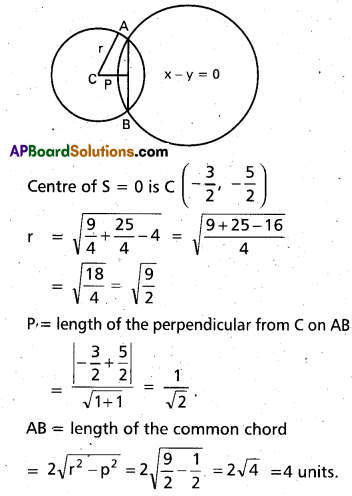
Question 19.
Show that the circles
S ≡ x2 + y2 – 2x – 4y – 20 = 0 ……………….. (1)
and S’ ≡ x2 + y2 + 6x + 2y – 90 = 0 ……………. (2)
touch each other internally. Find their point of contact and the equation of common tangent. [T.S. Mar. 15]
Solution:
Let C1, C2 be the centres and r1, r2 be the radii of the given circles (1) and (2). Then
C1 = (1, 2); C2 = (-3, -1); r1 = 5; r2 = 10
C1C2 = distance between the centres = 5
|r1 – r2| = |5 – 10| = 5 = C1C2
∴ The given two circles touch internally. In this case, the.common tangent is nothing but the radical axis. Therefore its equation is
S – S’ = 0
i.e., 4x + 3y – 35 = 0
Now we find the point of contact. The point of contact divides in the ratio 5 : 10 i.e., 1 : 2 (externally)
∴ Point, of contact
= [latex]\left(\frac{(1)(-3)-2(1)}{1-2}, \frac{(1)(-1)-2(2)}{1-2}\right)[/latex]
= (5, 5).
![]()
Question 20.
Find the equation of the circle whose diameter is the common chord of the circles
S ≡ x2 + y2 + 2x + 3y + 1 = 0 ……………….. (1)
and S’ ≡ x2 + y2 + 4x + 3y + 2 = 0 ……………….. (2)
Solution:
Here the common chord is the radical axis of (1) and (2). The equation of the radical axis is S – S’ = 0.
i.e., 2x + 1 = 0 …………………… (3)
The equation of any circle passing through
the points of intersection of (1) and (3) is (S + λL = 0)
(x2 + y2 + 2x + 3y + 1) + λ(2x + 1) = 0
x2 + y2 + 2(λ + 1)x + 3y + (1 + λ) = 0 ……………………. (4)
The centre of this circle is (-(λ + 1), [latex]\frac{3}{2}[/latex]).
For the circle (4), 2x + 1 = 0 is one chord. This chord will be a diameter of the circle (4) if the centre of (4) lies on (3).
∴ 2{-(λ + 1)} + 1 = 0
⇒ λ = -[latex]\frac{1}{2}[/latex]
Thus equation of the circle whose diameter is the common chord (1) and (2)
(put λ = [latex]\frac{1}{2}[/latex] in equation (4))
2(x2 + y2) + 2x + 6y + 1 = 0
Question 21.
Let us find the equation of a circle which cuts each of the following circles orthogonally
S’ ≡ x2 + y2 + 3x + 2y + 1 = 0 ………………… (1)
S” ≡ x2 + y2 – x + 6y + 5 = 0 …………….. (2)
and S” ≡ x2 + y2 + 5x – 8y + 15 = 0 ……………………. (3)
Solution:
The centre of the required circle is radical centre of (1), (2) and (3) and the radius is the length of the tangent from this point to any one of the given three circles. First we shall find the radical centre. For, the radical axis of (1) and (2) is
x – y = 1 ………………… (4)
and the radical axis of (2) and (3) is
3x – 7y = -5 …………………… (5)
The point of intersection (3, 2) of (4) and (5) is the radical centre of the circles (1), (2) and (3). The length of tangent from (3. 2) to the circle (1)
= [latex]\sqrt{3^{2}+2^{2}+3(3)+2(2)+1}=3 \sqrt{3}[/latex]
Thus the required circle is
(x – 3)2 + (y – 2)2 = (3[latex]\sqrt{3}[/latex])2
x2 + y2 – 6x – 4y – 14 = 0.
